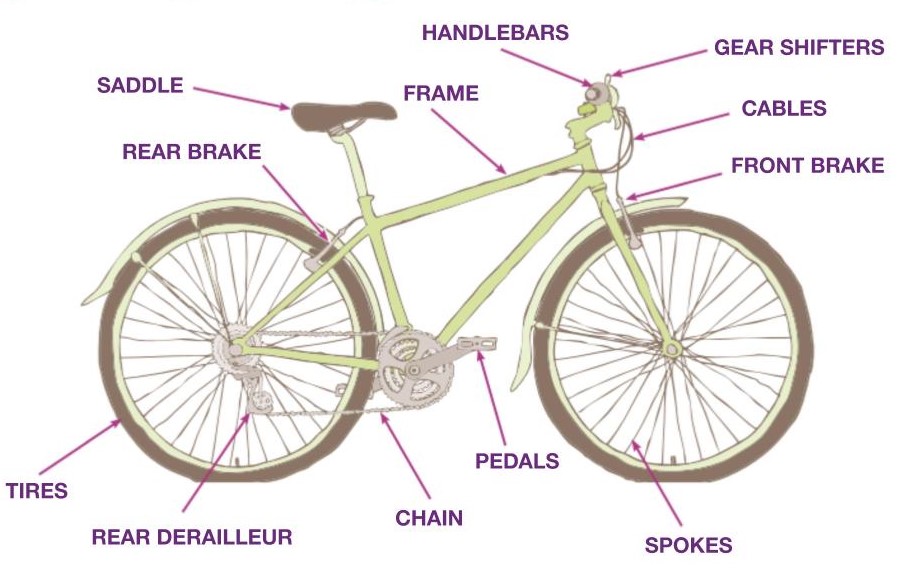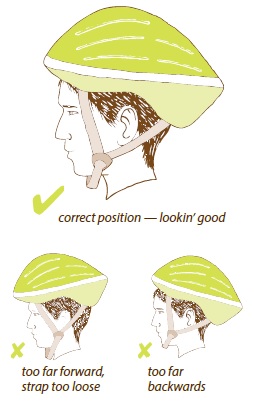Main menu
Tips for Getting Back on Your Bike
The COVID-19 outbreak has resulted in massive impacts on the way we move around. Biking remains an affordable, sustainable, and fun transportation option, and is a great way to get around during this pandemic (and beyond)! Here are 5 tips to help you get back into biking.
1.ABC Quick Check
Do this one minute pre-ride check every time you ride to ensure that your bike is ride-ready.

A = Air. Stand beside your bike and use your fingers to pinch each of your tires. They should both feel like a hard potato, not a squishy tomato! What can I do if I notice a problem? If your tires are too soft, use a pump to push more air into the tire through the tire valve. If it’s been a while since you rode, your tires may be brittle and have cracks. If this is the case, they should be replaced.
B = Brakes. Stand beside your bike, put both hands on the handlebars, and squeeze both brake levers. Pull the bike as hard as you can backwards, then push as hard as you can forwards. The tires of your bike should not move when you do this. If there is significant movement, your brakes should be adjusted. If you don’t feel confident that your brakes are working well, take your bike to a bike shop before riding it! There should be at least one working brake.
C = Chain. Stand next to your bike and reach down and spin your pedals backwards with your hand. Look - is there any dirt or twigs stuck in the chain? Is there a lot of rust? Does the chain move smoothly in a circle? Listen - you should hear continuous clicking, not clunking or jumping! What can you do if you notice a problem? Pick any dirt or twigs out of the chain. If there is a lot of rust, put some oil on it or have a bike mechanic lubricate or replace the chain. If the chain does not move smoothly in a circle, it may be your gears; to fix this, hop on and pedal your bike for a few feet (you may hear loud clunking - those are your gears changing!), then hop off and try checking your chain again.
Final check. Finally, shake your bike, bounce your bike, and make sure nothing falls off or sounds weird. Ride around the block before heading out on your ride to make sure everything is in working order.
If your bike has been in storage for a while or needs more maintenance than you can handle, take it to your local bike shop for a tune-up (list of bike shops currently operating during this time). A reminder HUB members receive discounts at over 40 local bike shops and bike-friendly businesses)
2. Gather the appropriate gear.

It is the law in British Columbia to wear a helmet when riding a bicycle. Try it on: It should fit comfortably and snugly. If not, check the fit using the 2-V-2 rule:
2 = Two fingers of space between your eyebrows and the helmet’s rim.
V = The helmet straps make a “V” shape around each ear
2 = Two fingers of space between your chin and the chinstrap.
If your helmet has a dial at the back tighten it before giving your head a little shake. The helmet should feel secure with very little movement. If you are in a crash or fall, or if you notice damage to your helmet, replace it.
Other accessories that will make for a safer ride:
- Front white light & rear red light/reflector (required at night but improves safety if also used during the day)
- Tire reflectors
- Bell
3. Pick a comfortable and safe route
Route planning has a HUGE impact on safety and enjoyment of your ride! There are many considerations to take into account when choosing a bike route, such as traffic, bike paths, speed, and even scenery.
Three safest route types:
- Cycle Track (separated bike lane)
- Residential street with bike route
- Residential street
Three least safe route types:
- Major street with parked cars
- Major street, with bike lane and parked cars
- Multi-use pathway*
*Multi-use pathways have relatively high rates of collision but they are not as severe because there are no cars involved. It’s important to practice courteous riding while sharing space with other riders, dog-walkers, skateboarders, and strollers. Give even more space especially in this time of physical distancing!
For more resources on planning your ride route see the Maps and Planning section of our resources page.
4. Avoid the door zone
Whether riding in a bike lane or on a shared street, you should always be sure to stay 1-2 m away from parked cars to avoid any opening doors. Some standard bike lanes are not painted outside of the door zone, so ride on the left side of the lane to be outside of the door zone. If you are opening a car door, remember to check for people biking before opening your door. Try the Dutch Reach next time you are exiting a car.
5. Practice Physical distancing on your ride.
Follow the advice from our provincial health authorities and “Go outside with your family, but stay away, keep your distance”. Keep practicing physical distancing including giving lots of room when passing other people biking or walking. Scan, signal, and scan again before passing someone with at least 2 metres of clearance. Lastly, don’t forget to wash your hands for at least 20 seconds once you’re home.
For more resources on biking confidently in the city, check out our Resources page and all of the digital events happening May 25-31, 2020 as part of Go by Bike Week.
